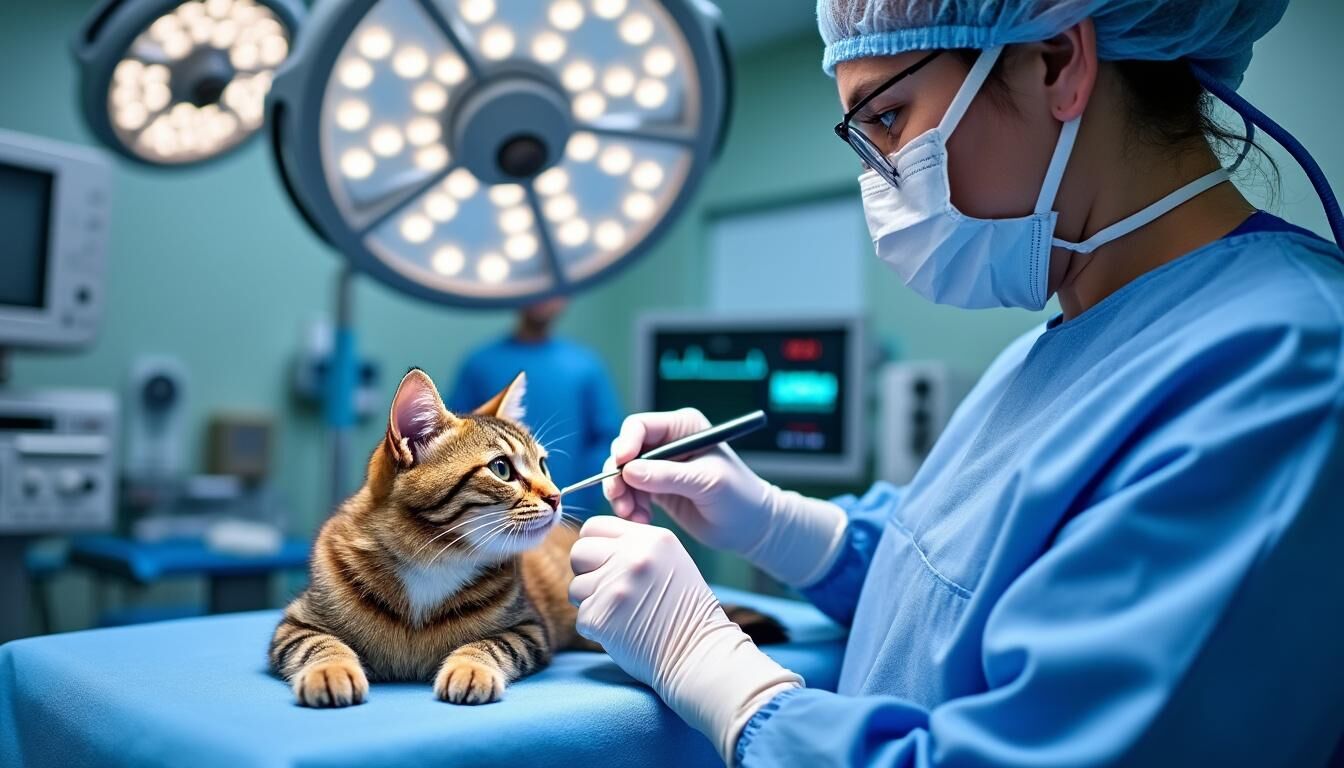The necessity of cat eye removal surgery, medically known as enucleation, often stems from serious ocular conditions threatening both the health and comfort of cats. These conditions may include severe eye trauma, advanced glaucoma, infections resistant to treatment, cancerous growths within the eye, or congenital defects impairing vision and causing continuous pain. Although the removal of an eye may seem drastic, veterinary specialists emphasize that cats typically adapt well and maintain a good quality of life post-operation. Understanding how long this surgery takes and what it entails helps pet owners prepare emotionally and logistically, while also appreciating the care and expertise involved.
Vets performing cat eye removal surgery prepare carefully due to the complexity related to the eye’s anatomy and surrounding delicate tissues. The procedure combines advanced surgical skill and thorough pain management strategies to ensure a safe experience for the animal. While the cost of the surgery varies by region and clinic, the investment goes toward preserving the comfort and longevity of the cat’s life. This overview explores the surgical steps, timing, and recovery phases, providing clear insights into what pet owners should expect at every stage.
Understanding Cat Eye Removal Surgery (Enucleation): Vet-Approved Insight
What Is Cat Eye (Ocular) Enucleation Surgery and Why Is It Performed?
Cat eye removal surgery, or enucleation, involves the complete removal of the eye and part of the surrounding tissues. It is a serious but often necessary surgery performed to alleviate conditions where the eye is either irreparably damaged or causes chronic pain and complications to the cat’s overall wellbeing.
Common reasons for enucleation include:
🐱 Severe trauma or injury to the eye, resulting in blindness or a painful situation
👁️ Advanced glaucoma causing unmanageable intraocular pressure and discomfort
🦠 Persistent infection unresponsive to antibiotics or other treatments
🎗️ Ocular tumors threatening nearby tissues and the cat’s health
🧬 Congenital defects causing constant irritation and abnormal development
Despite the emotional impact on pet owners, veterinarians affirm that cats adjust surprisingly well to the loss of one eye. The procedure prevents ongoing pain and prevents further complications linked to the diseased eye. Support from a skilled veterinary team ensures the animal’s comfort and smooth transition to life with one eye.
Cause 🐾 | Description 📋 | Effect on Cat Health 👨⚕️ |
|---|---|---|
Trauma | Blunt or penetrating injury to the eye | Severe pain, potential blindness, infection risk |
Glaucoma | Increased eye pressure causing damage | Chronic pain, irreversible blindness |
Infection | Persistent or resistant ocular infections | Eye destruction, systemic risk |
Tumor | Malignant or benign growths within the eye | Local tissue destruction, health compromise |
How Long Does Cat Eye Removal Surgery Take? Average Procedure Time Explained
Typical Duration: From Anesthesia Induction to Completion
The length of a cat eye removal surgery varies by individual case but typically spans between 30 minutes and 1.5 hours. On average, vets spend about 45 minutes to one hour on the surgery itself, excluding pre- and post-surgical preparation.
The timeframe includes several crucial phases:
💉 Induction of anesthesia – ensuring the cat remains completely unconscious and pain-free
✂️ Preparing and sterilizing the surgical area – facial and orbital cleaning
👁️ Careful removal of the eye and associated tissues to prevent future infection and ensure thorough treatment
🧵 Closing the surgical site with sutures – ensuring minimal scarring and faster healing
🛌 Monitoring recovery from anesthesia under close veterinary supervision
While the surgery itself is relatively swift, the entire process at the clinic can take several hours when including preparation and recovery monitoring.
Stage of Surgery ⏲️ | Typical Duration 🕑 | Notes 📝 |
|---|---|---|
Anesthesia induction | 10-15 minutes | Ensuring deep unconsciousness and stable vitals |
Surgical removal of the eye | 30-60 minutes | Depends on case complexity |
Anesthesia recovery | 30-45 minutes | Close monitoring to prevent complications |
Key Factors Affecting Cat Eye Removal Surgery Timing
Case Complexity, Surgical Technique, and Veterinarian Expertise
The duration of cat eye surgery depends heavily on several interrelated factors, creating variation from one cat to another:
🔍 Complexity of the case – Complicated trauma, large tumors, or infections extending around the eye tend to increase time.
🛠️ Surgical technique – Minimally invasive or laser-assisted methods may reduce time, while traditional techniques can take longer.
👩⚕️ Veterinarian expertise – Experienced vets or veterinary ophthalmologists often perform quicker surgeries with fewer intraoperative complications.
🐈 Cat’s health status – An obese, older, or medically fragile cat may require more monitoring and longer anesthesia time.
Occasionally, unexpected complications during surgery, such as hemorrhage or tissue adhesions, can prolong the procedure. The surgical environment and tools available also shape the time needed.
Factor ⚖️ | Impact on Surgery Time ⏳ | Notes 🗒️ |
|---|---|---|
Case complexity | High impact | Infections, tumors require more dissection |
Technique used | Medium impact | Laser less time-consuming, if available |
Veterinarian skill | High impact | Experienced surgeon reduces time and risks |
Cat’s health | Medium impact | Preexisting conditions require caution |
Pre-Surgical Preparation for Cat Enucleation: What Extends the Timeline?
Essential Steps: Fasting, Exams, and Ensuring Anesthesia Safety
Before undergoing cat eye removal surgery, comprehensive preparation is essential to minimize pain and avoid complications. This phase impacts the overall timing and can extend the process on the day of surgery.
Key preparation includes:
⏳ Fasting for about 8-12 hours to reduce anesthesia risks such as regurgitation
🔬 Thorough physical examinations to assess cardiovascular and respiratory health – essential because anesthesia impacts vital functions
💉 Blood work and other diagnostics to screen for conditions affecting surgery and recovery
📋 Detailed discussion between veterinarian and owner about cost, post-operative expectations, and medications
⚠️ Ensuring the cat is free of active infection to prevent spreading or worsening during surgery
These preparatory steps require time outside the surgery itself but are critical in safeguarding the cat’s health before anesthesia induction.
Preparation Step 🔧 | Typical Duration ⏰ | Purpose 🎯 |
|---|---|---|
Fasting | 8-12 hours | Reduce anesthesia risk |
Physical exam | 15-30 minutes | Evaluate suitability for anesthesia |
Blood work and diagnostics | 30-60 minutes | Detect underlying conditions |
Immediate Recovery and Aftercare: What Pet Owners Can Expect Post-Surgery
Pain Management, Wound Care, and Typical Healing Timelines
Following cat eye removal surgery, post-operative care is vital to promote recovery and reduce the risk of complications. Although the surgical phase is relatively brief, the healing process can last several days up to weeks, depending largely on the cat’s age and overall health.
Key components of immediate care include:
💊 Pain management through prescribed medications to ensure comfort and prevent stress
🩹 Regular monitoring and cleaning of the surgical site to avoid infection and encourage healing
📅 Scheduled follow-up visits with the veterinarian to assess wound healing and detect early complications
🛡️ Use of an Elizabethan collar to prevent the cat from scratching or irritating the surgery site
⚠️ Watch for signs such as swelling, mild bruising, or occasional nasal bleeding, which are usually temporary but require observation
The typical suture healing period ranges from 10 to 14 days, and the majority of cats return to normal behavior within two weeks. However, close supervision during the early postoperative days is essential for the best results.
Recovery Aspect 🛌 | Expected Timeframe ⏳ | Care Tips 📝 |
|---|---|---|
Initial anesthesia recovery | Within hours | Quiet, warm environment |
Wound healing | 10-14 days | Keep clean, monitor for infection |
Full behavioral recovery | 1-2 weeks | Prevent stress, limit activity |
Latest Advances, Pain Management, and Supporting Your Cat After Eye Removal
Modern Techniques: Laser Surgery, Prosthetics, and Your Cat’s Quality of Life
In recent years, technological advances have significantly impacted cat eye surgery, improving both procedure duration and outcomes. Notably, veterinary ophthalmologists now sometimes utilize laser surgery which can reduce bleeding, minimize infection risk, and shorten operation time.
Additionally, for cosmetic and psychological well-being, the option of including prosthetic eyes following enucleation has gained popularity. These prosthetics not only enhance the cat’s appearance but may also promote social ease with other animals or humans.
Regarding pain relief, careful administration of anesthesia ensures the cat experiences no pain during the surgery itself. Postoperatively, a combination of pain medications, often including NSAIDs or opioids prescribed by the veterinarian, guarantees effective management of discomfort while fostering recovery.
Owners can contribute positively to their cat’s experience by providing:
🧸 A calm, safe environment to reduce stress
🍲 Easy access to food and water while adjusting to vision changes
🛡️ Protective measures to prevent re-injury or accidents in unfamiliar surroundings
Most cats demonstrate remarkable resilience, regaining independence and mobility within weeks. Modern veterinary expertise, combined with compassionate care, ensures the cat’s quality of life remains excellent after eye removal.
Advancement 🚀 | Benefit ✨ | Impact on Surgery/Recovery ⏳ |
|---|---|---|
Laser Surgery | Minimized bleeding, cleaner cuts | Shorter surgery time, quicker healing |
Prosthetic Eye | Improved cosmetic appearance | Enhanced social interaction |
Advanced Pain Medications | Effective management of post-surgical pain | Smoother, less stressful recovery |

FAQ: Common Questions About Cat Eye Removal Surgery
How long is the cat under anesthesia during eye removal?
Typically, anesthesia lasts between 45 minutes and an hour, covering induction, surgery, and initial recovery phases.Can a cat live a normal life with one eye?
Yes, most cats adapt well, maintaining normal mobility, play, and quality of life shortly after recovery.What is the average cost of cat eye removal surgery?
The cost varies but generally ranges from several hundred to over a thousand dollars, factoring in consultation, surgery, anesthesia, and postoperative care.What are signs of complications after surgery?
Watch for excessive swelling, discharge, bleeding, or signs of infection. Regular check-ups help detect these early.How is post-operative pain controlled?
Veterinarians prescribe appropriate medications and may use local anesthetics and systemic drugs to manage discomfort.

